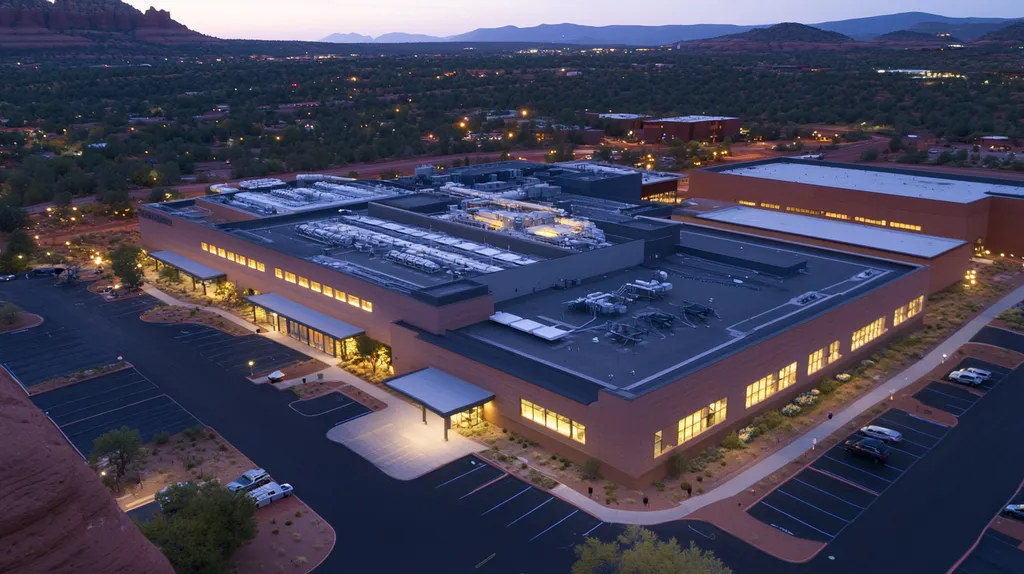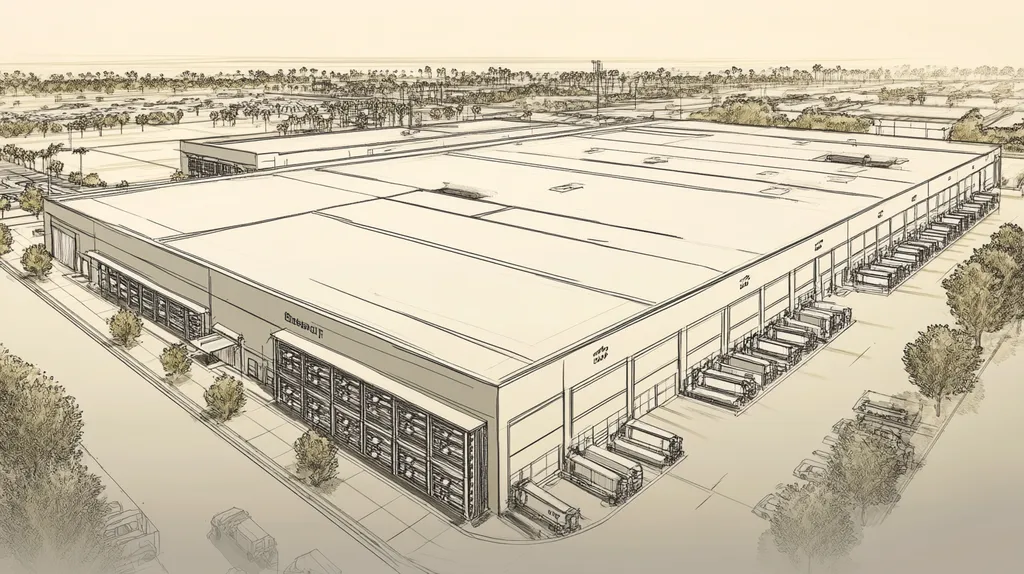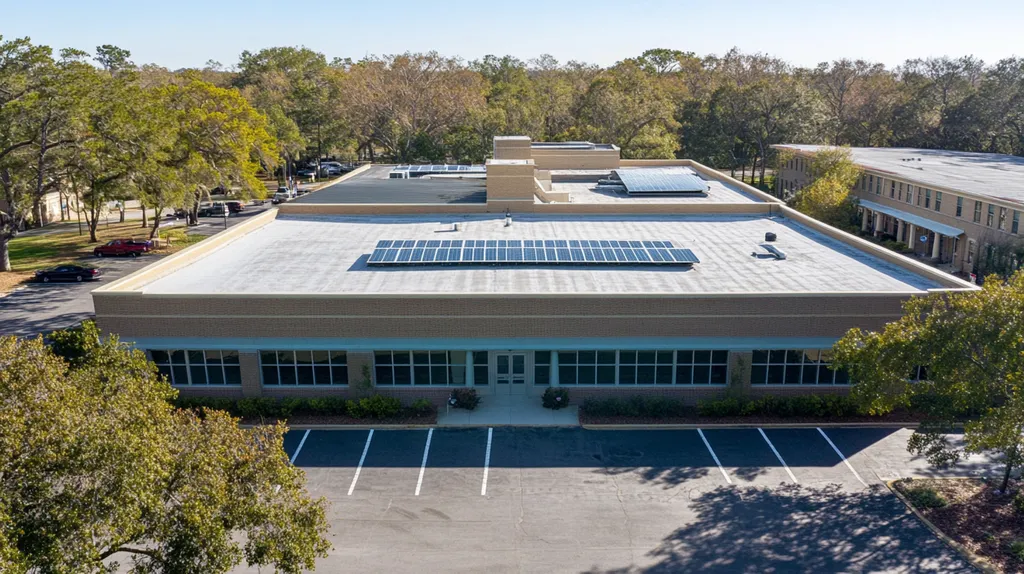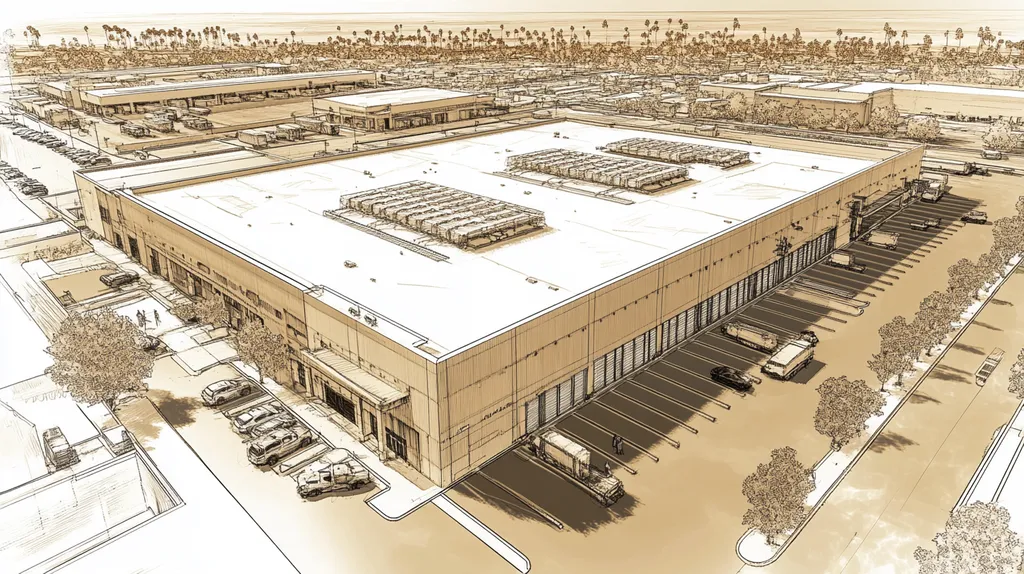Welcome to today’s Battle Royale featuring two roofing heavyweights: “Infrared Thermography” in the east corner versus “Visual Inspections” in the west!
Tonight’s showdown pits these contenders against each other across six punishing rounds designed to test every aspect of their performance for Equipment Replacement Indicators.
At stake? Millions in potential costs, decades of building protection, and the critical performance demands of modern commercial and industrial facilities.
Our professional judging panel will evaluate each round on technical merit, real-world performance, and value delivery. After all six rounds, we’ll declare our ultimate champion.
Ladies and gentlemen, facility managers and building owners… it’s time to rumble!
ROUND 1: INITIAL COSTS & INSTALLATION
Water damage from undetected roofing issues can devastate commercial properties, leading to extensive repairs and business disruptions. At Axiom D7, inspectors found that visible water stains, ceiling damage, and floor puddles are primary indicators of immediate maintenance needs. Understanding how different inspection methods detect these issues early is crucial for protecting your investment. (source: Axiom D7)
Material Expenses
Initial equipment costs vary significantly between infrared thermography and visual inspection methods. High-quality infrared cameras and associated software represent a substantial upfront investment, often ranging from $5,000 to $25,000 for commercial-grade systems.
Visual inspection tools are considerably less expensive, typically requiring only basic measurement devices and documentation equipment. This cost difference can be especially appealing for smaller facilities or those with limited maintenance budgets.
However, infrared systems can detect moisture intrusion and insulation problems before they become visible, preventing costly repairs. While visual inspections cost less initially, their limited detection capabilities often result in more expensive repairs later.
Installation Complexity
Implementing infrared thermography requires specialized training and certification. Technicians must understand thermal imaging principles, equipment calibration, and data interpretation, creating a steeper learning curve.
Visual inspection procedures are more straightforward, requiring basic roofing knowledge and safety training. This simplicity allows for faster deployment and easier staff training.
Despite easier implementation, visual inspections lack the precision and consistency of infrared technology. The advanced capabilities of infrared systems provide more reliable and comprehensive results, giving them an ADVANTAGE in this category.
Project Timeline
Infrared roof scans require specific environmental conditions and careful scheduling. Optimal scanning typically occurs during evening hours when temperature differentials are greatest, potentially extending project timelines.
Visual inspections can be conducted during normal business hours with fewer environmental restrictions. This flexibility allows for more immediate deployment and faster completion of initial assessments.
The superior accuracy of infrared scans reduces follow-up inspections and prevents overlooked issues that could cause delays. While visual inspections offer short-term speed, infrared technology’s precision leads to more efficient long-term maintenance scheduling.
ROUND 1 WINNER: INFRARED THERMOGRAPHY
ROUND 2: DURABILITY & LIFESPAN
Commercial roofing represents one of the most substantial facility investments, with replacement costs often exceeding $10 per square foot. Understanding when equipment and materials are approaching end-of-life is crucial for effective budget planning and preventing catastrophic failures.
The stakes are particularly high for aging roofing systems, where delayed replacement can lead to cascading damage affecting structural integrity, energy efficiency, and business operations.
Importance of Material Longevity
Different roofing materials exhibit distinct aging patterns and failure modes. Single-ply membranes typically show different deterioration signs than built-up roofing or modified bitumen systems, making accurate assessment crucial for timing replacements.
Infrared thermography excels at detecting early-stage material breakdown by identifying subtle temperature variations that indicate compromised areas. These scans can map deterioration patterns across entire roof sections, providing comprehensive insight into remaining material life.
Visual inspections often struggle to differentiate between surface-level wear and deeper material degradation. While experienced inspectors can spot obvious damage, they may miss underlying issues that accelerate material failure.
The ability to detect hidden deterioration gives infrared thermography a clear ADVANTAGE in assessing material longevity.
Impact of Weather Resistance
Weather exposure creates complex stress patterns in roofing systems, particularly at seams, flashings, and penetrations. These stress points often become failure initiation sites, making their early detection critical for replacement planning.
Infrared scanning identifies areas where weather exposure has compromised thermal resistance, even before visible damage appears. This capability allows facility managers to track degradation patterns and optimize replacement timing.
Traditional visual assessments can only evaluate surface-level weather damage, potentially missing deeper deterioration patterns. This limitation often leads to unexpected failures during severe weather events.
For weather resistance evaluation, infrared thermography shows a clear ADVANTAGE.
Maintenance Needs Over Time
Effective maintenance strategies depend on accurate condition assessment and deterioration tracking. Understanding how different roof sections age helps prioritize repairs and plan systematic replacements.
Infrared technology creates detailed condition maps that track degradation over time, enabling data-driven maintenance decisions. This systematic approach helps facility managers optimize repair investments and timing.
Visual inspections provide spot checks of obvious issues but struggle to establish deterioration trends. This limitation can result in reactive maintenance approaches that miss opportunities for preventive intervention.
The systematic tracking capabilities give infrared thermography an ADVANTAGE in maintenance planning.
ROUND 2 WINNER: Infrared Thermography
ROUND 3: PERFORMANCE FACTORS
Every day a failing commercial roof goes undetected represents significant financial risk. When equipment and materials begin deteriorating, the resulting damage can cascade through multiple building systems, leading to extensive repairs, business interruptions, and potential safety hazards. Early detection through proper inspection methods becomes the critical difference between planned maintenance and emergency replacement.
Impact on Equipment Longevity
Proper inspection methods directly influence how long roofing systems remain effective. Regular monitoring helps identify potential issues before they compromise the entire system’s integrity.
Infrared thermography detects moisture intrusion and thermal inefficiencies at their earliest stages. This early warning system allows facility managers to address small problems before they escalate into system-wide failures.
Visual inspections typically identify problems only after significant damage has occurred. By then, moisture may have already compromised insulation, membrane integrity, and structural components.
The ability to prevent premature aging through early detection gives infrared thermography a clear ADVANTAGE in equipment longevity.
Detection of Performance Degradation
Tracking performance decline requires systematic evaluation of the entire roofing system. Subtle changes in thermal efficiency, moisture levels, and material integrity often indicate impending equipment failure.
Infrared scanning creates detailed thermal maps showing exactly where and how quickly performance is declining. This data enables precise tracking of degradation patterns and helps predict future failure points.
Visual methods rely heavily on surface-level indicators that may not accurately reflect underlying performance issues. This limitation often leads to unexpected equipment failures and emergency replacements.
The precision in tracking degradation patterns gives infrared thermography an ADVANTAGE in performance monitoring.
Assessment of Repair Needs
Accurate repair assessment requires comprehensive understanding of both visible and hidden damage. Proper evaluation helps prioritize repairs and optimize maintenance budgets.
Infrared technology provides objective data about the location and severity of problems beneath the surface. This allows facility managers to make informed decisions about repair timing and scope.
Visual inspection methods frequently miss underlying issues that can accelerate equipment failure. Without complete information, repairs may address symptoms rather than root causes.
The ability to identify hidden damage gives infrared thermography an ADVANTAGE in repair assessment.
ROUND 3 WINNER: Infrared Thermography
ROUND 4: MAINTENANCE REQUIREMENTS
Ineffective maintenance strategies can slash a commercial roof’s expected lifespan by up to 50%, leading to premature replacement and unnecessary capital expenditure. The stakes are particularly high for facilities with aging roofing systems, where delayed identification of problems can cascade into catastrophic failures.
Understanding how different inspection methods impact maintenance effectiveness is crucial for protecting these substantial investments and preventing emergency replacements.
Inspection Frequency and Access
Regular roof inspections are vital for catching problems early and planning timely equipment replacement. Visible damage including cracked materials, water stains, and noticeable sagging often indicates serious underlying issues requiring immediate attention. (source: G. Fedale)
Infrared thermography can be conducted systematically without disrupting roofing materials, allowing for frequent comprehensive assessments. The non-invasive nature of thermal scanning means inspections can occur regularly without risking additional damage to the roof system.
Visual inspections require physical access to all roof areas, which can be challenging and potentially damaging to certain roofing materials. This limitation often results in less frequent or incomplete inspections of critical areas.
The ability to conduct thorough, non-destructive assessments gives infrared thermography an ADVANTAGE in inspection accessibility.
Detection and Documentation
Effective maintenance tracking requires detailed documentation of developing issues and deterioration patterns. This information forms the foundation for equipment replacement planning and budget allocation.
Infrared scanning creates precise digital records of subsurface conditions, including moisture infiltration and insulation degradation. These records can be compared over time to track problem progression and optimize replacement timing.
Visual assessments rely heavily on written descriptions and photographs of surface conditions, making it difficult to track subtle changes consistently. This documentation limitation can lead to missed maintenance opportunities and unexpected equipment failures.
The superior documentation capabilities give infrared thermography an ADVANTAGE in condition tracking.
Cost-Benefit Analysis
Maintenance investments must be weighed against the risk and cost of equipment failure. Understanding this balance helps facility managers justify inspection expenses and replacement decisions.
While infrared inspections have higher upfront costs, their ability to prevent major failures through early detection provides substantial long-term savings. Catching problems before they escalate helps avoid emergency replacement scenarios.
Visual inspections cost less initially but often miss developing issues until significant damage occurs. This reactive approach typically results in higher repair costs and more frequent equipment replacement.
The long-term cost savings potential gives infrared thermography an ADVANTAGE in maintenance value.
ROUND 4 WINNER: Infrared Thermography
ROUND 5: SUSTAINABILITY CREDENTIALS
With commercial buildings responsible for nearly 40% of U.S. energy consumption, roofing inspection methods directly impact environmental performance and operating costs. The right inspection approach can extend material lifespans by years while dramatically reducing energy waste. As sustainability regulations tighten and utility costs rise, choosing between infrared thermography and visual inspections has never carried greater financial and environmental implications.
Environmental Impact
Every square foot of compromised roofing insulation can waste thousands of BTUs annually through unnecessary heat transfer. Early detection of these thermal bridges is crucial for maintaining building envelope performance and minimizing environmental impact.
Infrared thermography precisely maps heat loss patterns across entire roof sections, enabling targeted repairs before energy waste becomes severe. This capability helps facilities maintain optimal thermal performance while reducing their carbon footprint.
Visual inspections cannot detect subtle thermal anomalies until they manifest as visible damage. By then, significant energy waste has already occurred through compromised areas.
The ability to prevent energy waste through early detection gives infrared thermography an ADVANTAGE in environmental impact.
Material Longevity
Sustainable roofing requires maximizing material lifespan while maintaining optimal performance. Premature material failure not only creates waste but also consumes additional resources through manufacturing and installation of replacements.
Infrared scanning identifies moisture intrusion and material degradation before they trigger cascading failure modes. This early warning allows targeted intervention that extends useful life while preserving material integrity.
Traditional visual assessments often miss developing issues until materials are beyond salvage. This reactive approach leads to premature disposal of otherwise serviceable roofing components.
The potential for lifespan extension gives infrared thermography an ADVANTAGE in material sustainability.
Energy Efficiency Compliance
Modern building codes and sustainability certifications increasingly mandate documented energy performance. Meeting these requirements demands precise assessment of thermal envelope efficiency.
Infrared technology provides quantifiable data on thermal performance and insulation effectiveness. These measurable results help validate compliance while identifying opportunities for efficiency improvements.
Visual inspections lack the capability to evaluate actual thermal performance. Without objective efficiency data, facilities may struggle to demonstrate compliance or optimize energy conservation.
The ability to document thermal performance gives infrared thermography an ADVANTAGE in compliance verification.
ROUND 5 WINNER: INFRARED THERMOGRAPHY
ROUND 6: SPECIALIZED APPLICATIONS
Every day a commercial roof operates with failing equipment puts millions in assets at risk. Water infiltration through deteriorating components can devastate inventory, disrupt operations, and compromise structural integrity. When puddles form on interior floors, it signals that water has already breached the roofing system, requiring immediate investigation. (source: Deschutes Roofing)
Equipment Performance Monitoring
Commercial roof systems rely on multiple integrated components working together. When one element begins to fail, it can trigger a cascade of problems throughout the entire system.
Infrared thermography provides detailed thermal mapping of equipment operation patterns. This capability allows facility managers to identify failing components before they impact surrounding systems.
Visual inspections can only assess external signs of equipment stress. Without the ability to detect internal thermal variations, developing problems often go unnoticed until failure occurs.
The ability to monitor internal equipment function gives infrared thermography an ADVANTAGE in performance assessment.
Leak Detection Systems
Water infiltration represents one of the most destructive forces affecting commercial roofing systems. Early detection of moisture intrusion is essential for preventing extensive damage.
Infrared scanning precisely locates moisture accumulation patterns beneath the surface. This technology can track water migration paths and identify entry points before visible damage occurs.
Traditional visual methods rely on spotting water stains or physical evidence of leaks. By the time these signs appear, significant damage may have already occurred to insulation and structural components.
The capability to detect hidden moisture gives infrared thermography an ADVANTAGE in leak detection.
Membrane Integrity Assessment
Roofing membranes provide critical protection against environmental elements. Understanding membrane condition is essential for timing equipment and material replacement.
Infrared technology identifies areas where membrane separation or deterioration has compromised system integrity. These scans reveal delamination and adhesion failures before they become visible.
Visual inspections can only evaluate surface-level membrane conditions. This limitation often results in overlooked problems that accelerate system deterioration.
The ability to assess subsurface membrane conditions gives infrared thermography an ADVANTAGE in integrity evaluation.
ROUND 6 WINNER: Infrared Thermography
AND THE WINNER IS…
After six grueling rounds of technical evaluation, we have our verdict…
In a stunning sweep of all six rounds, INFRARED THERMOGRAPHY claims the undisputed championship title in the battle of Equipment Replacement Indicators!
This dominant performance showcased infrared’s superior capabilities in early detection, comprehensive documentation, and long-term cost savings. From durability assessment to specialized applications, infrared’s ability to spot hidden problems before they become catastrophic failures proved decisive.
Yet don’t count visual inspections out completely! For smaller facilities with limited budgets or situations requiring quick spot-checks, traditional visual methods still serve an important role in the roofing maintenance arsenal.
Important Notice: Every building faces unique challenges based on local climate, construction type, and usage patterns. While this analysis highlights general advantages, specific circumstances may affect outcomes differently. Always consult qualified roofing professionals who can evaluate your particular situation and recommend the most appropriate inspection methods.
Ladies and gentlemen, when the final bell rings, remember this: In the high-stakes world of commercial roofing, choosing the right inspection champion isn’t just about winning rounds – it’s about protecting your investment with the most effective tools for your specific battle plan.
FREQUENTLY ASKED QUESTIONS
Q. What are the initial costs for commercial roof inspections?
A. Initial costs for inspections vary widely between methods. Infrared thermography requires significant investment in advanced equipment, typically ranging from $5,000 to $25,000. In contrast, visual inspections demand far less financial commitment, needing only basic tools, making them appealing for facilities with limited budgets.
Q. How does the lifespan of an industrial roof affect replacement timing?
A. The lifespan of roofing materials is critical for replacement timing. Different materials show unique deterioration patterns, some requiring prompt replacement to prevent severe structural damage. Infrared thermography is effective at detecting early material breakdown, helping in scheduling replacements before emergencies arise.
Q. How do infrared thermography and visual inspections differ in performance monitoring for commercial roofs?
A. Performance monitoring significantly varies between methods. Infrared thermography offers detailed thermal mapping, revealing hidden issues before they escalate, whereas visual inspections mainly focus on observable surface issues, often missing underlying problems. This can lead to unplanned repairs and system failures.
Q. What are the maintenance implications of using infrared thermography for commercial roofs?
A. Utilizing infrared thermography enhances maintenance effectiveness as it allows for non-invasive, frequent assessments without damaging roofing surfaces. Regular thermal scans provide vital data on the roof’s condition, enabling timely interventions that extend its lifespan and prevent costly emergency repairs.
Q. How does roofing inspection impact sustainability for commercial roofs?
A. Inspection methods directly affect sustainability efforts. Infrared thermography identifies energy loss early, enabling corrective actions that retain roofing materials and minimize waste. In contrast, traditional visual inspections often miss inefficiencies, leading to greater resource consumption and environmental impacts from premature replacements.
Q. What special applications can infrared thermography address in commercial roofing?
A. Infrared thermography offers specialized applications such as monitoring equipment performance, locating moisture intrusion, and assessing membrane integrity. These capabilities allow facility managers to detect underlying issues before they become visible, preventing extensive damage and maintaining system effectiveness over time.
Q. How often should a commercial roof undergo inspections?
A. Regular inspections are crucial for early issue detection. It is typically recommended to inspect commercial roofs at least twice a year, particularly before and after severe weather events. This frequency allows for timely identification of issues and effective maintenance planning to ensure long-term roof health.










